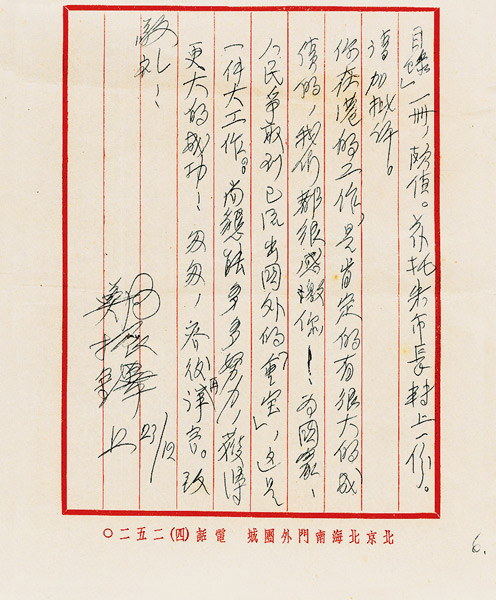Exhibits show China's efforts to get back lost cultural items
 0 Comment(s)
0 Comment(s) Print
Print E-mail China Daily, December 31, 2019
E-mail China Daily, December 31, 2019

In the early 1950s, when the newly founded People's Republic of China just began to recover from social upheaval and was still a poor country, a costly cultural mission was made a priority.
The endeavor was to rescue many national treasures from getting lost overseas.
Now, an exhibition at the National Library of China is displaying letters, notes and telegraph messages exchanged between Zheng Zhenduo, the first director of the National Cultural Heritage Administration after New China's founding in 1949, and a group of unsung heroes in Hong Kong.
A succession of wars resulted in cultural relics going from the mainland to Hong Kong, which was ruled by the United Kingdom at the time, attracting the attention of foreign collectors.
In 1951, following then-premier Zhou Enlai's guidance, Mid-Autumn Festival and Letter to Boyuan, dating back to the Eastern Jin Dynasty (317-420), among the most important paper-based works in Chinese fine art history, were bought from a private collector. The two calligraphy pieces cost 500,000 HK dollars (then $87,500), roughly 0.2 percent of China's total foreign exchange reserve at that time. The artworks returned to the Forbidden City-now the Palace Museum-in Beijing, where they were previously kept by Qing Dynasty (1644-1911) emperors.
Zheng led a rescue campaign from 1952 to 1958 to buy more treasures-paintings, calligraphy works and antique books, among others-in a well-planned manner by contacting Xu Bojiao, a patriotic banker in Hong Kong, and other influential figures in art collecting circles.
"Zheng was an outstanding representative among founders of New China's cultural heritage program," Liu Yuzhu, director of the National Cultural Heritage Administration, says at the opening ceremony of the exhibition. "He was devoted to protecting the country's culture in his lifetime."
Zheng's exhibited letters show the paintings and calligraphy works taken from the royal palace by China's last emperor Puyi were the most important targets of the collection campaign. Thanks to Zheng's effort, artistic hallmarks, such as the ancient painted masterpieces Night Revel of Han Xizai and Five Oxen were returned to the Palace Museum.
"There are few things that can be achieved without difficulty," he wrote in a letter. "The more challenging a thing is, the greater an opportunity we have to hone our ability to do it and build our self-confidence."
Coincidentally or not, the letters returned to Beijing a similar way to other rescued treasures.
In September, 166 letters and handwritten documents reflecting the 1950s' campaign appeared in an auction catalog in Hong Kong. Showing the country's will to collect the historical items, the National Cultural Heritage Administration contacted China Guardian Auctions, which had organized the sale.
To avoid the letters from going overseas, Guardian Auctions successfully bid for them at their own auction and donated them to the administration. They were transferred to the national library's permanent collection on Thursday when the exhibition started.
"These letters are priceless treasures that are a grand page of history," Chen Dongsheng, founder of Guardian Auctions, says. "The process of their return went smoothly. It was best that they were handed back to the country."
Guan Qiang, deputy director of the National Cultural Heritage Administration, says the letters will also provide key references for their upcoming work.
"The letters make our understanding of the historic rescue clearer," Guan says. "With further study, they can inspire the repatriation of more lost Chinese cultural relics from overseas."
This year marked a milestone in terms of bringing lost treasures back. Through negotiation and international judicial cooperation, 1,167 Chinese artifacts were returned from the United States, Italy and Japan, among other countries.
The process perhaps just echoes a Zheng slogan: "As long as it is a national treasure, we have to make our best effort."
The exhibition at the National Library of China runs through Feb 26.






Go to Forum >>0 Comment(s)